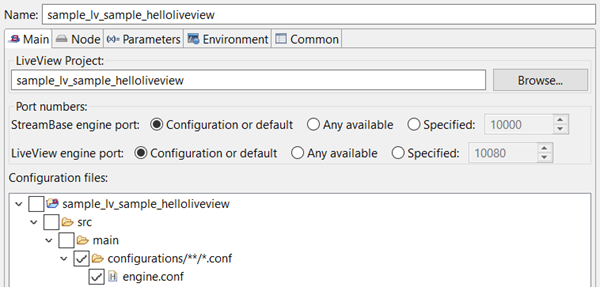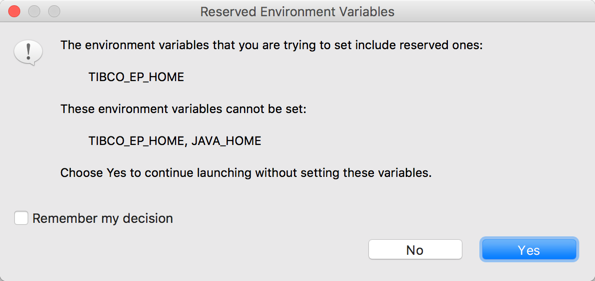Contents
The primary way to open the Run Configurations dialog for a LiveView project is:
-
In the Project Explorer view, right-click the name of your application's LiveView project. From the context menu, select >.
You can also use one of the following alternative methods:
-
Select > from the top-level menu.
-
Select from the drop-down arrow next to the (
 ) button in the
Studio toolbar.
) button in the
Studio toolbar.
Run configurations are stored as metadata in your Studio workspace. Thus, by default, your set of named Run Configurations is common to all projects in the current workspace.
The top row of each run configuration dialog contains the Name field, common to all tabs:
- Name
-
A configuration name is generated for you when you first run a fragment. You can change the name according to your site's standards. The name you enter is not reflected in the navigator pane on the left until you click Apply.
Studio automatically creates a new run configuration the first time you run a project, with the configuration taking the name of the LiveView project being run. These Run Configurations are created with default settings, and you can edit or copy them to specify custom settings.
You can also create a new run configuration from scratch. To do this, open the Run Configurations dialog and do one of the following:
-
In the left pane, right-click LiveView Fragment and choose New in the context menu.
-
In the left pane, select LiveView Fragment and click the New toolbar button.

-
Select the name of an existing run configuration and click the Duplicate toolbar button.
A named run configuration does not yet exist for a LiveView project until you have run the LiveView fragment for that project at least once.
To edit an existing run configuration:
-
Open the Run Configurations dialog.
-
Select the name of the configuration to edit.
-
Make changes in the tabs of the wizard and click the Apply button before you leave each tab.
-
Click to undo changes since the last saved version.
Note
The Run Configurations dialog restarts showing the last configuration you opened. This is not necessarily the configuration for the LiveView project whose name was selected when you invoked the Configurations dialog.
After applying your edits, you can:
-
Click to preserve your edits and exit the dialog.
-
In the Run Configurations dialog, click to run the edited run configuration right away.

|
- LiveView Project
-
Specify the path to the LiveView project to be run. Paths are measured from the root of the current Studio workspace. The easiest way to enter the correct path format is to browse for a project using the button. The resulting dialog shows a list of all projects in your workspace. Select the LiveView project of interest and click OK.

- StreamBase engine port
-
Specifies the Client API listening port for this EventFlow engine. Choose one of the following options:
- Configuration or default
-
Specifies that the EventFlow listening port is assigned by a configuration file of type
sbclientapilistenerin the project'ssrc/main/configurationsfolder. If no configuration file sets the listening port for this project, a random, unused port is assigned. - Any available
-
Select this control to specify any port not currently in use. This control is the same for Studio as setting
portNumber = 0in a configuration file. - Specified
-
Select this control to specify a particular listening port number for this fragment's EventFlow engine. This setting can override a port set in a configuration file for the same launch.
- LiveView engine port
-
Use this control to specify the API listening port for the LiveView server run with this LiveView project. The options are used as described for the StreamBase engine port above, except that the default port is 10080.
- Configuration files
-
Specify which configuration files to use in the next run or debug launch of this EventFlow project. By default, all configuration files in
src/main/configurationsare selected. If your project contains more than one configuration file of the same HOCON type, specify only one per type. For example, if your project experimentally contains two configuration files of typeldmengine, the launch halts with a runtime error. Select which configuration file to use for the next launch from Studio.

|
- Cluster
-
The default cluster name for Studio-initiated nodes is the system login name in effect when Studio started, and is not specified in a Run Configuration. You can change the default cluster name in Studio Preferences.
Alternatively, you can specify a cluster name on a per-run configuration basis in the Use name field.
- Node Name
-
This field specifies a name for the node that Studio creates to contain this fragment. This field uses a pattern of variables as described for the EventFlow Run Configuration.
- Node Installation Properties
-
Use this table to specify parameters for Studio to use when it installs a node to contain this fragment. See the description of the same field in the EventFlow Run Configuration.
The Parameters tab for LiveView Run Configurations has the same controls and is used the same way as the Parameters tab for EventFlow Run Configurations.

|
Caution
The settings in the Environment tab have a very different meaning for LiveView fragment Run Configurations than for the usual Java Run Configurations provided by Eclipse. Please read this section carefully.
- Environment variables to set
-
Remember that all LiveView fragments are launched into StreamBase Runtime nodes, and that nodes are always part of a StreamBase Runtime cluster.
Studio enables the Append environment to operating system environment setting by default. This means the shell environment for the operating system in which Studio runs is passed to and available to fragments running in nodes. Any variables specified in this tab can supplement the system settings, or can modify or override existing system environment variables.
You can select the Use specified environment only control to restrict the launched node's environment settings to those specified in this tab.
A StreamBase Runtime node has its environment set at node installation time. This has the following consequences:
-
Settings made in this tab can only affect the next node that Studio installs and starts. Remember that Studio installs a node and reuses it for the next launch of the same fragment. So even though this tab is part of the configuration for one LiveView fragment, if you add or change environment variables in this tab, for them to take effect, you must stop and remove any existing node for this fragment using toolbar buttons in the Clusters view. Then at the next launch of this configuration, Studio installs and starts a new node with the new environment settings.
-
Settings made in this Environment tab only affect nodes installed and started by Studio. These settings are not preserved in any fragment archive you create from this project. Therefore, these settings are not carried into any StreamBase Runtime archive that includes this fragment.
-
Settings made in this tab are independent of command line launches made with the epadmin command. The epadmin command appends the shell environment to the node's environment at node install time. If you have made any custom environment settings in this tab, you must repeat those settings in the shell in which you run the epadmin command, or in configuration substitution values.
The New/Edit Environment Variable dialog contains a Variables button, which is a feature inherited from Eclipse. Use this button to specify the value of an environment variable using one or more Eclipse system variables whose contents are resolved by Eclipse when this configuration is run. Use the Help button on this dialog for further information on each available variable.
The list of variables includes
${sb_home}, which is defined as the absolute file system path of the StreamBase installation directory as currently set in Studio's Preferences dialog.See Environment Variables for a further discussion of the ways environment variables are used in StreamBase.
-
- Reserved Environment Variables
-
Fragment launches in Studio cannot set customized values for the TIBCO_EP_HOME or JAVA_HOME environment variables because those have particular meaning for Studio operations. This is true even if these variables are inherited from the system environment.
Studio detects and blocks attempts to use these two variables, whether explicitly specified in this Environment tab, or inherited from the system environment. In this case, Studio displays a warning dialog like the following.

Select the Remember my decision check box to suppress this warning dialog for future fragment launches.

|
The settings in the Common tab are common to all Eclipse Run Configurations. Use Eclipse Help to learn how more about these options.
- Save as
-
This option determines where this run configuration is saved. The default setting, Local file, saves configurations in the workspace metadata area. As an alternative, you can select Shared file to save this run configuration as a file in one of your project folders. In this case, the run configuration is saved as
Name.launchNameis specified in the Name field. Specify the target project folder using the button. - Display in favorites menu
-
The favorites menu is a list of run configuration names that appears in the second section of the drop-down menu of the and buttons on the toolbar. The first section contains a changing list of recently Run Configurations. Add a configuration to the favorites section to keep it in the menu, even when other applications have replaced it in the recently-run section. This option performs the same function as the Organize Favorites option in the and drop-down menus.
- Encoding
-
Use this section to specify a non-default character encoding for log messages sent to the Console View (and optionally to a standard output file).
- Standard Input and Output
-
Allocate Console is selected by default. This specifies using the Console view to display logging messages written to standard output and standard error.
Input File is not supported by LiveView fragment launches.
Output File is unselected by default. To specify that standard output and standard error of your fragment's run are written to a log file, select the Output File check box, and enter a path to a file. If the specified file does not exist, it is created for you. If both Allocate Console and Output File options are selected, log messages are written to both places. You must designate the path to the file using Eclipse-specific syntax. Rather than typing a path, use the or buttons to navigate to a workspace or file system folder, and specify a file name. These buttons let Eclipse write the syntax for you. If you are familiar with the Eclipse syntax required in this field, you can use the button to build up a path from components.
is dimmed unless the option is selected. Select the check box to have log messages appended to the file specified in the Output field. If unselected (the default setting), the designated file is overwritten with each run of this configuration.
- Launch in background
-
Use this option to specify that the launching process itself runs in the background. (The LiveView server is always run in the background.) Selecting this box returns control to Studio immediately when you launch this configuration, without displaying the usual Starting Server dialogs.
By default, running a LiveView project automatically switches StreamBase Studio to the SB Test/Debug perspective, after prompting you to confirm. You can specify on the prompt dialog to not ask again.

|
The option to switch perspectives is not stored in the run configuration itself, but is a global setting for all StreamBase and LiveView applications, as specified in Studio Preference Settings.
